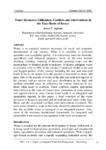| dc.description.abstract | Water is an essential resource necessary for social and economic
development of any country. When it is available in sufficient
quantities and acceptable quality, it is extensively used for domestic,
agricultural and industrial purposes. Some of the uses include
drinking; washing, watering of livestock, growing crops and the
manufacture of finished goods in industry. In Kenya, adequate water
is available only in 20% of the country’s landmass whilst in the rest
and biggest portion of the country including the arid and semi-arid
lands, it has to be mined from the ground or harvested in dams, and
pans. Due to the scarcity of water in the arid and semi-arid regions of
the country and its uneven and poor distribution in the high and
medium potential areas, its utilization for various functions in any
basin often leads to conflicts. These conflicts require appropriate
interventions in the form of conservation, protection of water sources
and apportionment to meet various water needs in an integrated and
sustainable manner. In this paper, a brief overview of the water
resources in Kenya is provided and the utilization of water in the Tana
Basin and the associated conflicts and interventions examined. The
main issues related to water in the basin should be addressed to ensure
that the available water is managed in an integrated manner. Also,
some of the necessary institutional frameworks for integrated and
sustainable water resource management in the basin are proposed. | en_US |

